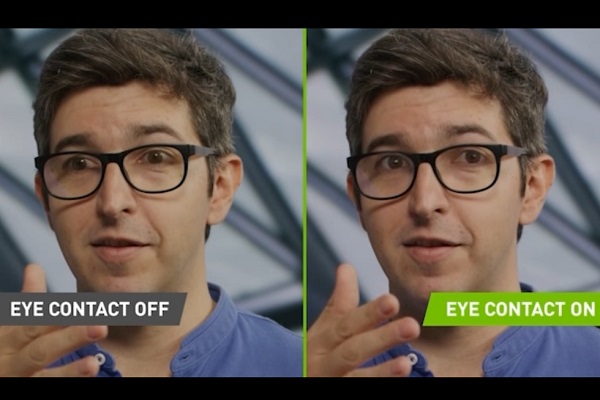Nvidia Deploys Deepfake Eye Contact Feature for Video Streaming

Nvidia has introduced an AI tool to deepfake eye contact through its Broadcast streaming and video conference software. The new Eye Contact feature employs AI to monitor a user’s eye line and digitally alter the feed to make them appear to always be looking into the camera, as seen in the image above. The idea is that someone giving a speech or momentarily distracted by something in the room won’t look like their gaze isn’t focused on the people watching them. Whether they use it to enhance a speech or just look like they arent’ bored in a meeting is up to them.
Deepfake Eye Contact
The tool leverages AI to monitor where a user’s real eyes are looking and then digitally reproduce and layer a version of them over the user’s face as needed. The AI-controlled eyes will even blink to enhance the illusion. The feature automatically turns off if the looks in a direction that would make looking at the camera impossible, but it doesn’t just abruptly disappear. Instead, it slowly shifts the digital eyes to match the real ones, a subtle transition compared to pupil teleportation. Nvidia claims the tool includes millions of lighting and eye color combinations to ensure that it will work for anyone. That said, the tool is still in beta, and Nvidia is soliciting feedback as it clearly believes this will be an attractive feature to potential users.
“The new Eye Contact effect moves the eyes of the speaker to simulate eye contact with the camera — achieved by estimating and aligning gaze. The eyes retain their natural color and blinks, and there’s even a disconnect feature in case you look too far away, to transition smoothly between simulated and real eyes,” Nvidia product line manager Gerardo Delgado explained. “Eye Contact is ideal for content creators seeking to record themselves while reading their notes or a script, or avoiding having to stare directly at the camera. Video conference presenters will look at the eyes of the person they’re speaking with, improving engagement with their audiences.”
The feature is similar to Apple FaceTime’s Attention Correction feature, which launched with iOS 13 in 2019. The deepfake AI employed by Nvidia seems to be more flexible, though the power behind the software is likely a reason for that. The Broadcast upgrade also includes a new Vignette effect to blur parts of the image while leaving others in focus. Nvidia describes it as an “AI-simulated bokeh visual” like the Japanese art style.
Follow @voicebotaiFollow @erichschwartz








